San Mateo - Communications and more Police Dept.
The City of San Mateo citizens service academy went back to the Police Dept.
on 21 May 1997 for a presentation by the Communications Manager and some
more tours of the Police Station. These are some of my notes and pictures...
Glenn Tenney
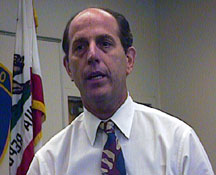 The evening began with a presentation by Mike Zarrella, the City's Communications
Manager. Mike was a police officer in New Jersey for four years before
coming out here as a dispatcher. His group is responsible for all communications
systems and related areas (e.g. cable TV) in San Mateo. Other than outsourcing
consultants in many areas, Mike's people are all dedicated to staffing
the 911 and communications center which is located at the Police Station.
Each year they handle 35,000 911 phone calls. with another 350,000 other
(general police, fire, etc. dialed as non-911) phone calls, plus some 2.1
million radio messages.
The evening began with a presentation by Mike Zarrella, the City's Communications
Manager. Mike was a police officer in New Jersey for four years before
coming out here as a dispatcher. His group is responsible for all communications
systems and related areas (e.g. cable TV) in San Mateo. Other than outsourcing
consultants in many areas, Mike's people are all dedicated to staffing
the 911 and communications center which is located at the Police Station.
Each year they handle 35,000 911 phone calls. with another 350,000 other
(general police, fire, etc. dialed as non-911) phone calls, plus some 2.1
million radio messages.
Most interesting, they have learned to staff up every month for the two
days before a full moon -- that's the time each month they have more
than expected incoming 911 calls... Equally interesting is that they don't
keep any statistics on how many 911 calls aren't really emergency calls.
That information would be very helpful.
San Mateo handles 911 calls for other cities too. For example, Hillsborough
pays us based on the number of 911 calls we receive from their residents.
That's a bit strange since we're providing a service that must
be there every hour of every day even if NO calls come in. Perhaps the
City Council will review this if the contract comes up for renewal (as Mike
said, this was established before he became manager).
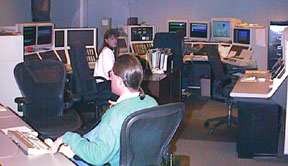 Mike ended his presentation by playing an audio tape of a depressing 911
call (about a death of a baby). The dispatchers have a very difficult job.
Imagine having to stay cool, calm, and collected while a mother is yelling
that her baby is dead... and there's nothing you can do except talk
her through trying mouth-to-mouth while radioing for a police car and fire
engine. Dispatchers start out by gaining State certification by passing
a written test; need to pass a polygraph exam followed by a psychological
and medical exam; and then enter 8-12 months of training. They work a 10
hour shift four days a week. While seated at their console (this picture
is from our previous visit) they have two or three computer screens, a 911
screen, a mouse, a keyboard, a phone "switchboard", a half dozen
radios (or more), and a few foot pedals to deal with. The earphone they're
wearing carries two or more conversations at once plus they need to talk
with each other in the communications room.
Mike ended his presentation by playing an audio tape of a depressing 911
call (about a death of a baby). The dispatchers have a very difficult job.
Imagine having to stay cool, calm, and collected while a mother is yelling
that her baby is dead... and there's nothing you can do except talk
her through trying mouth-to-mouth while radioing for a police car and fire
engine. Dispatchers start out by gaining State certification by passing
a written test; need to pass a polygraph exam followed by a psychological
and medical exam; and then enter 8-12 months of training. They work a 10
hour shift four days a week. While seated at their console (this picture
is from our previous visit) they have two or three computer screens, a 911
screen, a mouse, a keyboard, a phone "switchboard", a half dozen
radios (or more), and a few foot pedals to deal with. The earphone they're
wearing carries two or more conversations at once plus they need to talk
with each other in the communications room.
The rest of the evening we broke up into small groups that toured the 911
/ communications center, the shooting range, and spent some time with the
head of the SWAT team, a crime information analyst who showed us their access
to the VCIN system, and an officer who showed us their TRAK system.
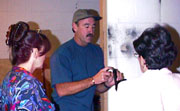
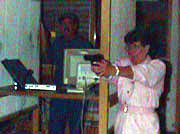 At the shooting range, Officer Dennis Barry showed us their computerized
simulator. It's a nice laserdisc video game where a standard issue
9mm hand gun has been modified to "fire" a laser instead of bullets.
The room was dark so that the video projection and laser targeting would
work, which is why the picture here of Pat Hines taking aim is so dark (I
don't know why the flash didn't work better...).
At the shooting range, Officer Dennis Barry showed us their computerized
simulator. It's a nice laserdisc video game where a standard issue
9mm hand gun has been modified to "fire" a laser instead of bullets.
The room was dark so that the video projection and laser targeting would
work, which is why the picture here of Pat Hines taking aim is so dark (I
don't know why the flash didn't work better...).
We were presented with a variety of scenarios (I did fairly well). Knowing
we couldn't get hurt if we were "shot", made it much easier.
But the problem was to decide in a fraction of a second whether to shot
or not... Dennis replayed some scenarios changing them from a person pulling
out a gun and shooting to a person taking out the same gun, but this time
carefully placing it down on a counter and putting his arms up in the air.
The difference between someone shooting at you or not in these two scenarios
was literally less than a quarter of a second. What would YOU do?
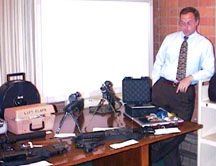 Sgt. Kevin Raffaelli showed us some of the equipment and weapons that San
Mateo's SWAT team use. In large cities (e.g. Los Angeles) SWAT teams
are a full time position. In San Mateo, like many other cities, the SWAT
team is composed of police officers who volunteer to be on 24 hour call
in addition to their regular duties. The budget for the SWAT team is so
tight that they don't have enough of the special helmets (that can withstand
a 9mm round) that they got as Gulf-War surplus.
Sgt. Kevin Raffaelli showed us some of the equipment and weapons that San
Mateo's SWAT team use. In large cities (e.g. Los Angeles) SWAT teams
are a full time position. In San Mateo, like many other cities, the SWAT
team is composed of police officers who volunteer to be on 24 hour call
in addition to their regular duties. The budget for the SWAT team is so
tight that they don't have enough of the special helmets (that can withstand
a 9mm round) that they got as Gulf-War surplus.
Andrea Lozano showed us the VCIN system. San Mateo can tie in to the State's
Violent Crime Information Network to do a variety of searches (e.g. name,
age, address, aliases, scars, etc.). San Mateo maintains their own database
and does not have any way (yet) to transfer data from the State's VCIN
system into our own database.
We were told that although this is supposed to be a database of VIOLENT
crime offenders, that it is actually a database of sexual offenders. This
database, or a portion of it, is also going to end up soon on a CD-ROM at
many (all?) police stations around California to allow citizens to query
for sexual offenders as per Meagan's Law. So, which is it --- is this
a VIOLENT crime database or is it a SEXUAL crime database? Will people
convicted of violent crimes be mistakenly listed as sex offenders?
The TRAK system is a system to easily build up a poster to aid in locating
abducted and missing children. This was built in part by assistance of
Hewlett Packard Company, so it's no surprise that it uses an HP computer
(PC clone), an HP scanner, and an HP color printer. Once the photo is scanned
in and the text filled in, it can be sent out to sites in the department's
"address book". For faxing, they send it once to an AT&T
system that then resends the fax to all of the recipients. For file transfers,
they can dial other TRAK systems directly and then upload the poster. Watching
it run, I wish that someone with a Macintosh had talked with them first.
Everything they were doing (and MORE) is done every day on Macs (and much
faster too!). Oh well, strive for mediocrity...
Go back to the Citizens' Service Academy page
Go back to our San Mateo page
Go back to gtenney.com's page
This site Copyright © 1997 Fantasia Systems Inc.
 The evening began with a presentation by Mike Zarrella, the City's Communications
Manager. Mike was a police officer in New Jersey for four years before
coming out here as a dispatcher. His group is responsible for all communications
systems and related areas (e.g. cable TV) in San Mateo. Other than outsourcing
consultants in many areas, Mike's people are all dedicated to staffing
the 911 and communications center which is located at the Police Station.
Each year they handle 35,000 911 phone calls. with another 350,000 other
(general police, fire, etc. dialed as non-911) phone calls, plus some 2.1
million radio messages.
The evening began with a presentation by Mike Zarrella, the City's Communications
Manager. Mike was a police officer in New Jersey for four years before
coming out here as a dispatcher. His group is responsible for all communications
systems and related areas (e.g. cable TV) in San Mateo. Other than outsourcing
consultants in many areas, Mike's people are all dedicated to staffing
the 911 and communications center which is located at the Police Station.
Each year they handle 35,000 911 phone calls. with another 350,000 other
(general police, fire, etc. dialed as non-911) phone calls, plus some 2.1
million radio messages.  Mike ended his presentation by playing an audio tape of a depressing 911
call (about a death of a baby). The dispatchers have a very difficult job.
Imagine having to stay cool, calm, and collected while a mother is yelling
that her baby is dead... and there's nothing you can do except talk
her through trying mouth-to-mouth while radioing for a police car and fire
engine. Dispatchers start out by gaining State certification by passing
a written test; need to pass a polygraph exam followed by a psychological
and medical exam; and then enter 8-12 months of training. They work a 10
hour shift four days a week. While seated at their console (this picture
is from our previous visit) they have two or three computer screens, a 911
screen, a mouse, a keyboard, a phone "switchboard", a half dozen
radios (or more), and a few foot pedals to deal with. The earphone they're
wearing carries two or more conversations at once plus they need to talk
with each other in the communications room.
Mike ended his presentation by playing an audio tape of a depressing 911
call (about a death of a baby). The dispatchers have a very difficult job.
Imagine having to stay cool, calm, and collected while a mother is yelling
that her baby is dead... and there's nothing you can do except talk
her through trying mouth-to-mouth while radioing for a police car and fire
engine. Dispatchers start out by gaining State certification by passing
a written test; need to pass a polygraph exam followed by a psychological
and medical exam; and then enter 8-12 months of training. They work a 10
hour shift four days a week. While seated at their console (this picture
is from our previous visit) they have two or three computer screens, a 911
screen, a mouse, a keyboard, a phone "switchboard", a half dozen
radios (or more), and a few foot pedals to deal with. The earphone they're
wearing carries two or more conversations at once plus they need to talk
with each other in the communications room.
 At the shooting range, Officer Dennis Barry showed us their computerized
simulator. It's a nice laserdisc video game where a standard issue
9mm hand gun has been modified to "fire" a laser instead of bullets.
The room was dark so that the video projection and laser targeting would
work, which is why the picture here of Pat Hines taking aim is so dark (I
don't know why the flash didn't work better...).
At the shooting range, Officer Dennis Barry showed us their computerized
simulator. It's a nice laserdisc video game where a standard issue
9mm hand gun has been modified to "fire" a laser instead of bullets.
The room was dark so that the video projection and laser targeting would
work, which is why the picture here of Pat Hines taking aim is so dark (I
don't know why the flash didn't work better...). Sgt. Kevin Raffaelli showed us some of the equipment and weapons that San
Mateo's SWAT team use. In large cities (e.g. Los Angeles) SWAT teams
are a full time position. In San Mateo, like many other cities, the SWAT
team is composed of police officers who volunteer to be on 24 hour call
in addition to their regular duties. The budget for the SWAT team is so
tight that they don't have enough of the special helmets (that can withstand
a 9mm round) that they got as Gulf-War surplus.
Sgt. Kevin Raffaelli showed us some of the equipment and weapons that San
Mateo's SWAT team use. In large cities (e.g. Los Angeles) SWAT teams
are a full time position. In San Mateo, like many other cities, the SWAT
team is composed of police officers who volunteer to be on 24 hour call
in addition to their regular duties. The budget for the SWAT team is so
tight that they don't have enough of the special helmets (that can withstand
a 9mm round) that they got as Gulf-War surplus.